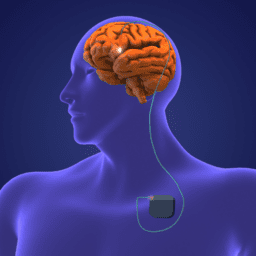If you’re considering Deep Brain Stimulation (DBS), chances are you have a few questions. Maybe you’re wondering what to expect from the surgery. Maybe you’re curious about safety or recovery timelines. Or maybe you want to hear what people who have been living with DBS think of their experience.
To help with this, we surveyed Davis Phinney Foundation Ambassadors who have had DBS. We asked them what they thought were the most important things a person with Parkinson’s who is considering DBS should know. Over half of the people who responded to our survey had their first programming visit eight or more years ago. One-third of the respondents had their first programming performed less than two years ago. Note that not all of our ambassadors contributed to this survey.
Read on for the three main themes that stood out in the responses we received.
PICK THE RIGHT CARE TEAM
Many responses we received referenced the importance of carefully selecting the specialists who you have join your care team. At minimum, this includes your surgical team and your programmer.
Multiple respondents specifically highlighted the importance of having your surgery performed by an experienced surgeon at a well-regarded surgical center. Michelle Lane is one ambassador who highlighted this advice.
Michelle was diagnosed with Parkinson’s in 2000, when she was 32, and had DBS surgery in 2010. Michelle advised that someone considering DBS for Parkinson’s should “go to a center that has performed many DBS procedures and has a low infection rate. Ask about the different system options for DBS, the doctor’s recommendation, and why they feel that system is best for you.” If the answer to this last question is about the care provider’s experience without reference to your individual circumstances, this may be a cue to seek another opinion or explore an alternative surgical center.
Max Brogi echoed the spirit of Michelle’s message. He wrote, “The key to DBS is to find a great surgery team.” Max added that it’s important to have a member of the team that has deep knowledge of the imaging processes that will help guide the placement of your DBS leads and who has “an acute understanding of how DBS affects brain behaviors.” Max has had DBS since 2021.
“Having faith in your surgeon’s abilities and obtaining as much information as you need to feel safe and secure is important to the success of the DBS procedure.” – Patty Wargo
Gregory Ritscher, who was diagnosed with Parkinson’s in 2011 and had DBS in 2023, offered a similar perspective. Gregory highlighted the importance of carefully selecting your DBS team and noted that your team may need to include more just a neurologist, DBS programmer, and a neurosurgeon. You may also want to have relationships with an occupational therapist, physical therapist, and speech therapist. When possible, it’s good to have a baseline visit and have a relationship with these care team members before your surgery.
Gregory also noted the importance both of having a good fit regarding your care team’s “bedside manner” and the details of your surgery, including the chosen lead location, the exact device you’ll be receiving, and whether or not you’ll be under general anesthesia.
It’s critical that your care team members have experience that aligns with your surgical and device preferences. Moreover, it is best if everyone on your care team has considered your specific circumstances and is “on-board” with your DBS-related decisions.
UNDERSTAND THE DETAILS
Gregory was not alone in his advice related to the details. Many respondents to our survey highlighted what they thought you should discuss with your care team in the early stages of exploring whether you think DBS may be right for you.
Multiple respondents recommended talking with your care team about what stimulation location they think would be best for you and why. The subthalamic nucleus (STN) and globus pallidus internus are the two typical lead placement locations for people with Parkinson’s. There is ongoing research and conversation amongst experts about the differences in outcomes when applying DBS to these different locations.
“LOCATION, LOCATION, LOCATION…you want a surgeon who will get the lead in the right place.” – Bart Narter
Multiple ambassadors also said it was important to understand what symptoms are more and less likely to respond to DBS treatment. On this subject, Patty Wargo said, “DBS does not resolve all of the Parkinson’s symptoms. Be sure to discuss realistic expectations with your movement disorders neurologist as well as the neurosurgeon and be sure to meet and talk with a representative from the company that developed your DBS system.”
Patty also noted that there are more DBS systems today than there were when she had her surgery. Every system is different, so it is important to consider the differences—including the support teams the different manufacturers may have available for you, both locally and remotely.
Three other details to consider with your care team are whether to have your surgery awake or asleep, whether to have a single surgery or multiple surgeries, and whether to select a rechargeable battery or a non-rechargeable battery.
Our friends at University of Colorado Denver have an excellent resource to help you start learning about many details related to DBS. This resource includes sections covering symptoms most likely to respond to treatment with DBS and the different DBS devices that are available. You can also find much more information through our DBS hub.
BE PATIENT BUT PROACTIVE WITH PROGRAMMING
Many survey respondents noted that it may take time for you and your care team to optimize your treatment after DBS surgery. Over two-thirds of those who responded said it took three or more DBS programming visits for them to experience the most significant benefits they’ve experienced from DBS.
Marty Acevedo, who lived with Parkinson’s for more than 10 years before having DBS surgery in 2016, says that DBS gave her her life back. But Marty also says she knows that everyone’s experience will be unique and that tuning treatment with DBS can take time. She says, “As with Parkinson’s, every experience with DBS is different. Be patient with programming and realistic with your expectations.”
Explaining his own experience with programming, Joe Narciso says,
“You need a doctor who will spend enough time with you to get your settings right. My first doctor, who I was very happy with, moved to the city, forcing me to see a new doctor. The new doctor could tell I was struggling. I was in a wheelchair, and I was speaking in one-word sentences, and I thought it was just the progression of disease. The new doctor started seeing me for two-hour visits, and he kept tweaking the programming until he got me out of the wheelchair and back to being able to speak normally. It was miraculous. Programming is everything.”
Another ambassador suggests that you explore changing to a different programmer if you or your care team think your programming is not helping you enough. They added that they “feel as though in the first year of DBS a person with Parkinson’s should be able to be programmed once a month if necessary.” While this may not be an attainable goal in your specific location or circumstances, it is more and more common for this to be possible. Regardless, the core message is worth keeping in mind: if you and your care team think the results of your programming are not as good as it could be, it may be appropriate to seek advice from an alternative programming specialist. Be patient, but proactive.
SOME FINAL THOUGHTS FROM OUR AMBASSADORS
DBS very often has a positive impact on quality of life for people with Parkinson’s. Of the ambassadors who responded to our survey, 53% said that DBS helps them more than they thought it would. The remaining 47% said that DBS helped them about as much as they thought it would. More than 90% of ambassadors who responded to the survey said that if they had to make the decision to have DBS again knowing what they know now, they would make the same decision to have DBS.
That said, in responding to our survey, multiple ambassadors also acknowledged that DBS results seem to vary as much as experiences of Parkinson’s do. Since no two Parkinson’s journeys are exactly the same, if you are considering DBS, discuss your individual experience with your family and as many members of your care team as you can to help you evaluate your whether you want to pursue the treatment.
“DBS was a turning point in my journey with Parkinson’s. It met my expectations: reducing the dosage of medications per day, tremors ceased, and mild dyskinesias eliminated. I still experience other bothersome symptoms, such as drooling, small and illegible handwriting, and a softer voice, and I still utilize other treatments—including physical, occupational, and speech therapy, as well as ongoing exercise—to deal with these symptoms.” – Patty Wargo
In other words, it is the same with DBS as with other aspects of living with Parkinson’s: you can help yourself have the best outcomes by doing your own research and talking candidly with your care team—and remember, it’s never too early to start learning and preparing for those conversations.
If you’d like to connect with an ambassador who contributed to this survey—or any other Davis Phinney Foundation Ambassador—you can do so on our ambassador search page.
ADDITIONAL RESOURCES
Webinar Recording: Living with DBS 0-3 Years
Webinar Recording: Living with DBS 6+ Years
Webinar Recording: Talking with a DBS Programmer
This DBS educational resource is supported by a grant from Medtronic.
This content was written by the Davis Phinney Foundation.


















